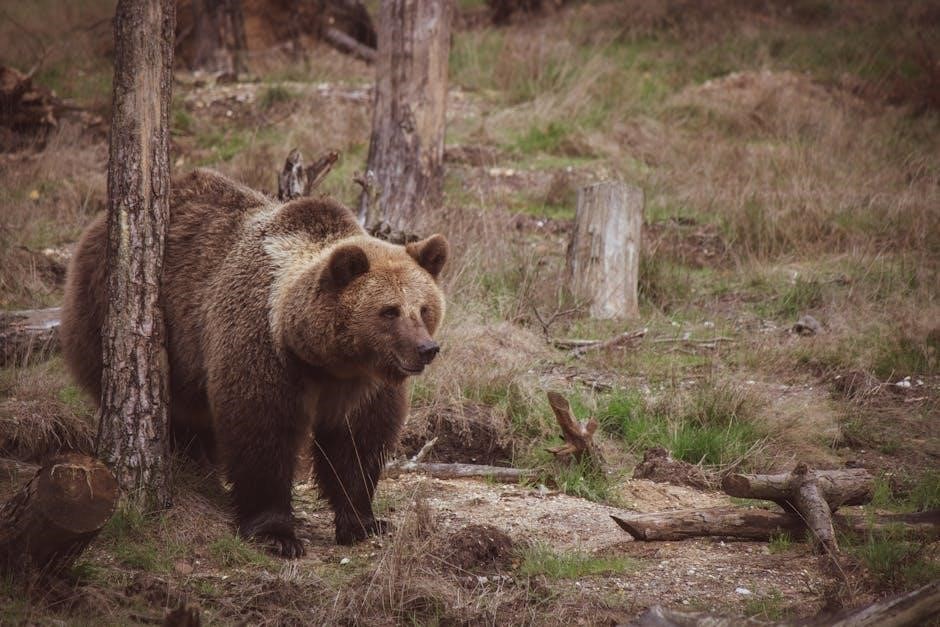Brown Bear, Brown Bear, What Do You See? is a timeless children’s classic by Bill Martin Jr. and Eric Carle, celebrated for its rhythmic storytelling and vibrant illustrations. The PDF version offers convenient access to this beloved book, preserving its colorful visuals and engaging layout for young readers.
1.1 Overview of the Book
Brown Bear, Brown Bear, What Do You See? is a charming children’s book written by Bill Martin Jr. and illustrated by Eric Carle. The story follows a repetitive, rhythmic pattern, making it engaging for young readers. Each page introduces a new animal and color, fostering recognition and anticipation. The PDF version preserves the vibrant illustrations and layout, ensuring an immersive reading experience. This beloved classic is celebrated for its simplicity, educational value, and ability to captivate early learners.
The book’s enduring popularity stems from its timeless themes and engaging format, making it a staple in early childhood education and home libraries alike.
1.2 Importance of the PDF Version
The PDF version of Brown Bear, Brown Bear, What Do You See? is highly valued for its convenience and accessibility. It allows parents and educators to easily share the book across devices, making storytelling versatile and portable. The digital format preserves Eric Carle’s iconic collage illustrations and the book’s original layout, ensuring an engaging visual experience. Additionally, the PDF’s clarity and color accuracy maintain the story’s charm, offering a reliable way to enjoy this classic tale in modern, tech-savvy environments while supporting early childhood learning and development.

Authors and Illustrators
Bill Martin Jr. and Eric Carle collaborated to create this beloved children’s classic. Martin’s rhythmic storytelling and Carle’s vibrant collage illustrations make the book a timeless treasure for young readers.
2.1 Bill Martin Jr.: Biography and Contributions
Bill Martin Jr. was a renowned children’s author, best known for Brown Bear, Brown Bear, What Do You See? and Chicka Chicka Boom Boom. With over 300 books written, his works are celebrated for their rhythmic text and educational value. Martin’s contributions to children’s literature focus on early reading skills, making learning fun and engaging. His collaborations with illustrators like Eric Carle have left a lasting impact on the genre, ensuring his stories remain beloved by generations of young readers.
2.2 Eric Carle: Biography and Illustrative Style
Eric Carle is a celebrated author and illustrator, renowned for his distinctive collage technique and vibrant colors. Born in 1929, Carle’s work often explores nature and education, as seen in Brown Bear, Brown Bear, What Do You See?. His unique style, featuring hand-painted tissue papers, has captivated readers worldwide. Carle’s contributions to children’s literature emphasize learning through visual and textual engagement, making his books timeless classics that foster creativity and understanding in young minds.

Book Structure and Content
Brown Bear, Brown Bear, What Do You See? features repetitive text, introducing animals and colors in a rhythmic flow. The PDF preserves this engaging structure, ideal for young readers.
3.1 Repetitive Text and Rhythmic Flow
Brown Bear, Brown Bear, What Do You See? captivates young readers with its repetitive text and rhythmic flow. The PDF version maintains this structure, making it easy for children to follow and remember the story. Each page introduces a new animal and color, creating a predictable pattern that encourages participation. The rhythmic cadence, combined with Eric Carle’s vibrant illustrations, makes the book engaging and memorable. This format aids in early language development and fosters a love for reading in young learners.
3.2 Animal Characters and Color Recognition
Brown Bear, Brown Bear, What Do You See? introduces a variety of animal characters, each paired with a distinct color. The PDF version vividly presents these elements, engaging young readers with Eric Carle’s iconic collage illustrations. Children are drawn to the repetitive introduction of animals like the “red bird,” “yellow duck,” and “blue horse,” fostering both color recognition and animal identification. This structure not only enhances early learning but also encourages vocabulary development and visual association, making the PDF a valuable tool for interactive and educational reading experiences.
3.3 Narrative Flow and Anticipation Building
The PDF version of Brown Bear, Brown Bear, What Do You See? masterfully employs a repetitive structure to create a sense of rhythm and flow. Each page predictably asks, “What do you see?” encouraging young readers to anticipate the next animal and its color. This pattern builds excitement and engagement, as children eagerly await the reveal of the subsequent character. The digital format preserves this dynamic storytelling, allowing the narrative to unfold seamlessly and maintain the suspense that captivates children and fosters a love for reading.

Themes in the Book
Brown Bear, Brown Bear, What Do You See? explores themes of color recognition, animal identification, and repetition. The rhythmic text and vibrant illustrations create a engaging, predictable pattern, fostering early learning and a love for reading in young children.
4.1 Color Recognition
Brown Bear, Brown Bear, What Do You See? introduces young readers to various colors through its vivid illustrations and repetitive text. Each animal in the story is associated with a specific color, helping children connect hues with objects. Eric Carle’s collage-style artwork enhances this learning process, making colors appear bold and distinct. This interaction between text and visuals creates an engaging way for children to recognize and memorize colors, fostering an early appreciation for the world’s chromatic diversity in a fun and accessible manner.
4.2 Animal Recognition
Brown Bear, Brown Bear, What Do You See? introduces children to a variety of animals, fostering early recognition and curiosity. Each page features a different animal, such as a red bird, a yellow duck, and a blue horse, presented in a repetitive and engaging format. Eric Carle’s distinctive collage illustrations bring these creatures to life, making them memorable for young readers. The PDF version ensures these visuals are preserved, allowing children to easily identify and name the animals, enhancing their understanding of wildlife in a playful and educational manner.
4.3 Repetition and Rhythm
Brown Bear, Brown Bear, What Do You See? employs a repetitive question-and-answer format, creating a rhythmic flow that captivates young readers. The predictable structure, with its rhyming text, makes it easy for children to follow and remember. This repetition enhances phonological awareness and language development, while the rhythmic cadence adds a musical quality, making the story engaging and fun to read aloud. The PDF version preserves this rhythmic structure, ensuring the storytelling experience remains dynamic and interactive for children.

Educational and Developmental Benefits
Brown Bear, Brown Bear, What Do You See? enhances early learning by teaching color and animal recognition, promoting narrative skills, and fostering language development through repetition and rhythm.
5.1 Learning Colors and Animals
Brown Bear, Brown Bear, What Do You See? introduces young readers to a variety of colors and animals through its repetitive and engaging text. Each page features a different animal, such as a red bird, a purple cat, and a blue horse, accompanied by vivid illustrations that help children associate colors with specific creatures. This structure makes learning colors and animal recognition fun and interactive, encouraging children to participate and predict the next animal in the sequence. The PDF version ensures these visuals remain crisp and vibrant, enhancing the learning experience for digital readers.
5.2 Developing Narrative Skills
The repetitive structure of Brown Bear, Brown Bear, What Do You See? helps children anticipate and predict the narrative flow, fostering early storytelling abilities. Each animal’s introduction builds anticipation, encouraging children to engage actively with the story. The rhythmic text and patterned sequence in the PDF version make it easier for young readers to follow along and understand how narratives are constructed. This structure supports the development of critical thinking and language skills, preparing children to create and retell their own stories.
5.3 Enhancing Language Development
The rhythmic and repetitive text in Brown Bear, Brown Bear, What Do You See? enhances language development by introducing young readers to simple, predictable sentences. The PDF version preserves the books engaging format, allowing children to easily follow along and recognize words. The use of colorful animal names and repetitive phrases aids in vocabulary expansion and memory retention. This structure helps children develop phonological awareness and builds a strong foundation for early language skills, making the PDF an invaluable tool for fostering linguistic growth in young learners.

Benefits of the PDF Version
- Convenient access on various devices, ideal for storytelling sessions.
- Preserves vibrant illustrations and layout, enhancing visual engagement.
- Cost-effective and easily sharable for educational purposes.
6.1 Convenience and Accessibility
The PDF version of Brown Bear, Brown Bear, What Do You See? offers unparalleled convenience, allowing readers to access the book on various devices such as tablets, laptops, and smartphones. This digital format is ideal for bedtime reading, classroom activities, or interactive storytelling sessions. Additionally, the PDF can be easily shared among parents, educators, and students, making it a versatile tool for fostering early childhood development. Its accessibility ensures that the timeless narrative reaches a wider audience, promoting literacy and engagement in diverse settings.
6.2 Preserving Illustrations and Layout
The PDF version of Brown Bear, Brown Bear, What Do You See? meticulously preserves Eric Carle’s iconic illustrations and the book’s original layout. High-resolution images ensure vibrant colors and crisp details, maintaining the visual appeal that captivates young readers. The digital format faithfully reproduces the spacing, typography, and design elements of the print version, ensuring an immersive experience. This attention to detail allows the PDF to uphold the artistic integrity of the original, making it a true digital representation of a beloved classic.
Legal Considerations
Accessing the Brown Bear, Brown Bear, What Do You See? PDF requires adherence to copyright laws. Obtain the file from authorized sources to ensure ethical access and support authors.
7.1 Copyright Laws and Ethical Access
Accessing the Brown Bear, Brown Bear, What Do You See? PDF requires adherence to copyright laws. Ensure the file is obtained from authorized sources like reputable retailers or libraries. This ethical approach supports the creators and promotes legal digital content consumption. Violating copyright laws can have legal consequences and undermines the work of authors and illustrators. Always verify the source’s legitimacy to enjoy the book responsibly while respecting intellectual property rights.
7.2 Supporting Authors and Illustrators
By accessing the Brown Bear, Brown Bear, What Do You See? PDF legally, readers directly support Bill Martin Jr. and Eric Carle’s creative work. Purchasing or borrowing from authorized platforms ensures royalties go to the creators, encouraging future literary contributions. This ethical practice promotes sustainability in children’s literature, allowing authors and illustrators to continue producing educational and engaging content for young audiences while fostering a culture of respect for intellectual property.
Accessing the PDF
The Brown Bear, Brown Bear, What Do You See? PDF can be accessed through libraries, educational platforms, or trusted websites, ensuring convenient and legal access to the book.
8.1 Sources: Libraries and Online Platforms
Public libraries and educational websites provide easy access to the Brown Bear, Brown Bear, What Do You See? PDF. Many libraries offer free digital loans, while platforms like OnPdf ensure high-quality downloads. These sources support legal access, benefiting early childhood education and home reading experiences. Parents and educators can explore these options to find the PDF, ensuring they comply with copyright laws and support the creators’ work. These resources are invaluable for fostering literacy and engagement in young learners.
8.2 Trusted Websites for Download
OnPdf.org is a trusted platform for downloading the Brown Bear, Brown Bear, What Do You See? PDF, ensuring high-quality resolution and color accuracy. Other reliable sources include Scribd, Google Books, and public libraries offering digital loans. Educational websites and platforms like OverDrive also provide legal access. Always verify the source’s credibility to avoid unauthorized downloads. These trusted websites ensure a safe and ethical way to access the book, supporting the work of Bill Martin Jr. and Eric Carle while maintaining the integrity of their creation.
Technical Aspects of the PDF
The PDF version maintains high image resolution and color accuracy, preserving Eric Carle’s iconic illustrations. Text clarity is ensured for readability, enhancing the rhythmic flow and engaging young readers effectively.
9.1 Image Resolution and Color Accuracy
The PDF version of Brown Bear, Brown Bear, What Do You See? prioritizes high image resolution and precise color accuracy to preserve Eric Carle’s iconic collage illustrations. These technical details ensure that the vibrant colors and textures of the original artwork remain intact, providing young readers with an immersive visual experience. The clarity of the images and faithful color reproduction are essential for maintaining the book’s engaging and educational qualities, making the PDF a reliable format for enjoying this classic tale digitally.
9.2 Text Clarity and Layout Preservation
The PDF version of Brown Bear, Brown Bear, What Do You See? ensures text clarity and preserves the original book’s layout, maintaining the rhythmic flow of Bill Martin Jr.’s words. The bold colors and repetitive text are perfectly aligned, creating an engaging experience for young readers. The digital format retains the balance between visual and textual elements, ensuring that the story’s educational and entertaining qualities remain intact. This preservation is crucial for maintaining the book’s original charm and effectiveness in early childhood education.

Activities and Resources
The PDF version offers printable resources like flashcards and activity sheets, enhancing engagement. Companion activities, such as puppet shows and story retelling, extend the learning experience for young readers.
10.1 Companion Activities for Engagement
Engaging activities like puppet shows and story retelling enhance the learning experience. The PDF version inspires creativity with printable resources, such as flashcards and animal prototypes. These tools help children interact with the story’s colorful characters and rhythmic text. Activities like sing-along sessions with melodies, such as Twinkle Twinkle, Little Star, further captivate young minds. Tactile animal prototypes, inspired by the book, encourage hands-on learning. These companion activities make the story immersive, fostering both fun and educational development for children.
10.2 Printable Resources and Extensions
The Brown Bear, Brown Bear, What Do You See? PDF is complemented by printable resources, such as flashcards and activity sheets. These tools aid in color and animal recognition, enhancing interactive learning. Tactile animal prototypes, inspired by the books characters, can be printed for hands-on activities. Extensions like matching games and crafts further engage children, making the story a comprehensive educational experience. These resources are ideal for both home and classroom settings, fostering creativity and reinforcing the books themes in a fun and accessible way.
Cultural Impact
Brown Bear, Brown Bear, What Do You See? is a children’s classic, beloved for its rhythmic storytelling and vibrant illustrations. Its popularity and legacy have made it a cornerstone in children’s literature, influencing early learning and cultural engagement worldwide.
11.1 Popularity and Legacy
Brown Bear, Brown Bear, What Do You See? is a timeless children’s classic, widely acclaimed for its engaging rhythm and vibrant visuals. Its enduring popularity has made it a staple in early childhood education, inspiring countless adaptations and educational resources. The book’s legacy lies in its ability to foster a love for reading and learning, while its PDF version ensures its accessibility and appeal to new generations of readers and educators alike.
11.2 Influence on Children’s Literature
Brown Bear, Brown Bear, What Do You See? has profoundly influenced children’s literature with its innovative use of repetitive text and vibrant illustrations. The book’s rhythmic structure and color-animal associations have set a standard for engaging young readers. Its success has inspired similar works, and its PDF version continues to be a valuable resource for educators, fostering early literacy and creativity. The collaboration between Bill Martin Jr. and Eric Carle remains a benchmark for effective storytelling in children’s books, shaping the genre’s future.
Brown Bear, Brown Bear, What Do You See? remains a beloved classic, offering timeless educational value through its rhythmic storytelling and vibrant illustrations. The PDF version enhances accessibility, ensuring its enduring impact on early childhood learning and literacy development.
12.1 Summary of Importance
Brown Bear, Brown Bear, What Do You See? is a timeless classic that has captivated young readers with its rhythmic text and colorful illustrations. The PDF version ensures accessibility, preserving the books vibrant visuals and engaging layout. It fosters early literacy skills, color recognition, and narrative development, making it a valuable resource for educators and parents. The convenience of the digital format enhances its educational impact, ensuring its legacy as a foundational tool in childhood learning and development.
12.2 Final Thoughts on Benefits
The Brown Bear, Brown Bear, What Do You See? PDF is a invaluable resource for early childhood education, offering a blend of engaging storytelling and visual learning. Its rhythmic text and vibrant illustrations foster language development, color recognition, and narrative skills in young children. The convenience of the digital format makes it accessible for parents and educators, ensuring its timeless appeal continues to inspire future generations. This book remains a cornerstone in fostering a love for reading and learning in children worldwide.